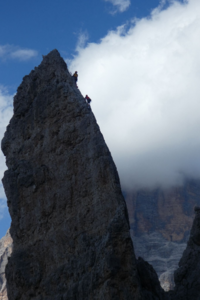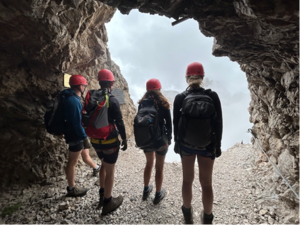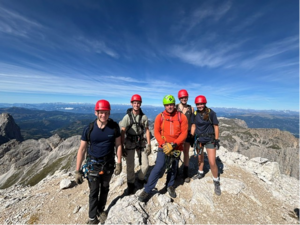In this article, OCdt Rosie Brown and OCdt Annabelle Vaughan describe the many challenges and lessons learnt from the South West OTR climbing and via ferrata trip to the Dolomites.
Towards the end of the summer a group of 30 OCdts gathered in Wyvern barracks ready to begin Ex DELAGO COMICI. For some, 2 weeks of climbing, beginning with Rock Climbing single pitch foundation (RCF) and progressing onto sport climbing, multi pitch seconding and gaining multi pitch proficiency. For others, an introduction into via ferrata, climbing technique and expedition planning, culminating in a 2-night expedition staying in local refugios, gaining them their Summer Mountaineering Foundation. For the first 6 days we were based in Cortina, focusing on nailing down the basics of rock climbing and exploring local via ferratas.
The climbers began at Sass de Stria and Cinque Torre, bottom roping to nail down basic belaying skills and climbing technique whilst some more experienced climbers had a recap on climbing sport routes and stripping them out. Sass de Stria’s east face was a great super accessible first crag and the views from Cinque Torre were inspired, even from the top of the single pitches. Across the week in Cortina, instructors rotated pairs of OCdts to introduce multipitch climbing. The greater exposure and feeling of being high up are part of what makes multipitch that next level, putting some OCdts into their stretch zone. Introducing multipitch was also key to familiarizing with climbing terminology and communication. With OCdts already eager to lead, the importance of “Watch me” and stressing the error of shouting “Take in Slack” were much needed lessons facilitated through multi pitch climbs.
Meanwhile more technical aspects of climbing were being recapped at single pitch crags (Piccolo Lagazuo) concurrent with initial sport leads for some members of the group. This included introduction to gear placement and the physics of anchors as well as calming rituals such as belly breathing and the pros and cons of an alpine knee.
The via ferrata groups enjoyed completing the nearby routes, including some of the original via ferrata trails, complete with tunnels and building remnants from the First World War. Each day their confidence and competence grew, enabling them to tackle more difficult wires, facing steeper terrain and needing to learn better climbing technique in order to complete them. In the same area as the climbers, these groups also summited Sass de Stria and other surrounding mountains and felt incredibly privileged to be able to conduct this ALeRT training in such an impressive landscape.
Unfortunately, the Italian sun didn’t always hold out, and on these lesser weather days, OCdts could choose between indoor climbing wall sessions to improve technique or Cascade di Fanes, a waterfall via ferrata. It was a great chance for the climbers to experience a taste of the via ferrata and enjoy the amazing landscape of the Dolomites even in less desirable weather. Occasionally we rolled the dice and got lucky. One of my best days was multipitching with three other OCdts and two instructors at Cinque Torre, where we spent the morning hoping we hadn’t just wasted euros on the chairlift up only to get rained on. Thankfully we climbed Torre Inglese (Via Normal 4***) and Quata Bassa ( Morro torro, onto via normal 3***) before being the last people on the chair back down, with only 2 minutes to spare! Our last day in Cortina wasn’t so lucky, with plenty of rain at Cinque Torre, causing us to abandon crag and shelter in a café, fortunately not before some multipitches were topped out, a rope rescued and some doing their first unassisted multi-pitch, swinging leads with another OCdt. It was a short day but even still we made the absolute most of it – The route (Bassa 13, 4c **) was 2 short pitches on bolts with a walk off top out and was one of my biggest highlights of the trip and a great way to finish being in Cortina.
Then it was onto Phase 2 – Canazei. Moving day was mostly uneventful. With annoyingly good weather and only one broken down combi the transition onto the next campsite was smooth. Now in Canazei we had access to some different crags, some more amazing Dolomite landscapes, and more options for via ferrata expeditions.
The via ferrata groups turned to exploring some of the new routes in the area, but predominantly to planning their expeditions. They were tasked with finding routes to span from refugio to refugio, maintaining suitability for the group ability, planning safety precautions and budgeting appropriate amounts for both food and accommodation. This facilitated more in-depth leadership training, for some being allocated a command appointment and dealing with everything from team management to presenting thr proposed plans. The groups of between four and eight people set off on their two-night expeditions, unfortunately split into one-night at a time due to inclement weather, facing long days of walking but the excitement of a refugio stay at the end. This unique opportunity felt massively special and the stay in such remote areas only added to the wholly rewarding nature of the trip. These expeditions not only built on the confidence we had gained in the first week, but also enabled us to be properly immersed in the dramatic Dolomite landscape, for some being on the Marmalada glacier, and others being on alternative routes, such as the Pisciadù Refugio.
The expeditions themselves were not just incredible experiences to enjoy the via ferrata but also provided a great opportunity to fully engage in the ALeRT training, having to deal with dynamic assessment of the area, maintaining teamwork, recognising strengths and weaknesses of the team, and pushing ourselves into the stretch zone. The guidance provided by our instructors was so valuable in this respect and encouraged reflection on our experiences in a constructive way to better ourselves as potential leaders and members of a team.
For the climbers with more bad weather looming on the forecast, it was vital that we made the most of our first day. At the south face of Piz Ciavasez, sport climbs were being racked up whilst 2 instructors and 4 OCdts prepared to climb 10 pitches. Rampa del Torro generated the most exposure I had experienced all trip and if that wasn’t surreal enough, 7 pitches up, a free soloing Italian pensioner cruises by us in crocs (in sports mode) continuing upwards casual as ever. We got a mini via ferrata (a bit of cheese wire on the cliff edge) to aid our very alpine walk off and some amazing views on the descent.
After a rainy weather day spent discussing the merits of bouldering and the discounts at the La Sportiva factory store we were back on the crag for the last few days of the trip. We visited Settore funiva and ferrata crags at Sellaronda and City of rock to round up our time climbing in the Dolomites.
This trip has facilitated development across both individuals and the unit in a hugely positive way. OCdts really enjoyed being able to get to know other OCdts from the opposite half of the OTR, reflecting on the positive impact this will have on unit cohesion. Many participants specifically acknowledged moments where they felt outside their comfort zone and what they learnt about how they dealt with panic and whether it was constructive or not. There has been overwhelming positive feedback about the quality of the trip and all participants have expressed a huge gratitude to be offered an amazing experience. We hope more AT opportunities will be available for OCdts to help develop both individuals and the unit.
Thank you to the Ulysses Trust whose expedition grant enabled this expedition. Thank you to all the instructors who enabled the activities, adapted to changes and were patient when teaching new skills. In particular, thank you to WO2 Martin Corfield, the UATO, who put in so much time and effort to organise and successfully run such a fantastic trip!




